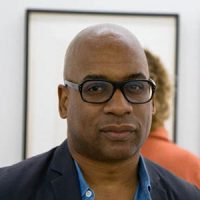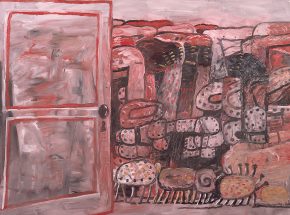

Glenn Ligon is an American conceptual artist whose work explores race, language, desire, and identity. He engages in intertextuality with other works from the visual arts, literature, and history, as well as his own life.
In 1989, he mounted his first solo show, “How It Feels to Be Colored Me,” in Brooklyn. This show established Ligon’s reputation for creating large, text-based paintings in which a phrase chosen from literature or other sources is repeated over and over, eventually dissipating into murk.
In 1994, the art installation “To Disembark” was shown at the Hirshhorn Museum and Sculpture Garden in Washington, D.C. The title alludes to the title of a book of poetry by Gwendolyn Brooks. “To Disembark” functions in both works to evoke the recognition that African Americans are still coping with the remnants of slavery and its ongoing manifestation in racism. In one part of the installation, Ligon created a series of packing crates modeled on the one described by ex-slave Henry “Box” Brown in his “Narrative of Henry Box Brown who escaped from Slavery Enclosed in a Box 3 Feet Long and 2 Wide.” Each crate played a different sound, such as a heartbeat, a spiritual, or contemporary rap music. Around each box, the artist placed posters in which he characterized himself, in words and period images, as a runaway slave in the style of 19th century broadsheets circulated to advertise for the return of fugitive slaves. In another part of the exhibition, Ligon stenciled four quotes from a Zora Neale Hurston essay, “how it feels to be colored me,” directly on the walls: “I feel most colored when I am thrown against a sharp white background,” “I remember the very day that I became colored,” “I am not tragically colored,” and “I do not always feel colored.” Ligon found Hurston’s writing illuminating because she explores the idea of race as a concept that is structured by context rather than essence.
In “A Feast of Scraps” (1994–1998), he inserted pornographic and stereotypical photographs of black men, complete with invented captions (“mother knew,” “I fell out” “It’s a process”) into albums of family snapshots including graduation photographs, vacation snapshots, pictures of baby showers, birthday celebrations, and baptisms, some of which include the artist’s own family. Like almost all of Ligon’s art, this project draws out the secret histories and submerged meanings of inherited texts and images.
Another series of large paintings was based on children’s interpretations of 1970s black-history coloring books. In 2005, Ligon won an Alphonse Fletcher Foundation Fellowship for his art work. In 2008, Ligon’s piece “Warm Broad Glow” was selected to participate in the Renaissance Society’s group exhibit, “Black Is, Black Ain’t”. In 2010, he won a United States Artists Fellow award.
In 2009, President Barack Obama added Ligon’s 1992 “Black Like Me No. 2” to the White House collection. The first comprehensive mid-career retrospective devoted to Ligon’s work is being held at the Whitney Museum of American Art from March 10 through June 5, 2011.
www.en.wikipedia.org/wiki/Glenn_Ligon
Website
http://www.glennligonstudio.com/



